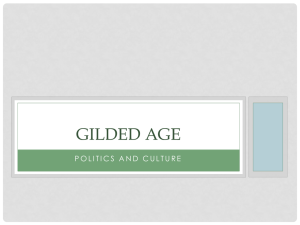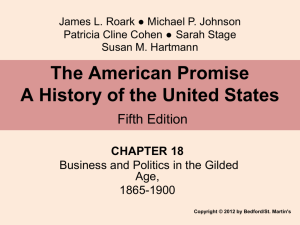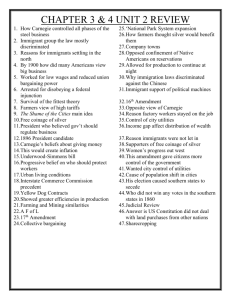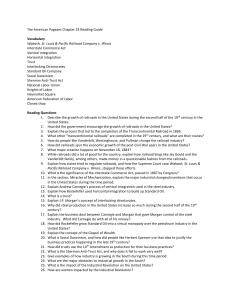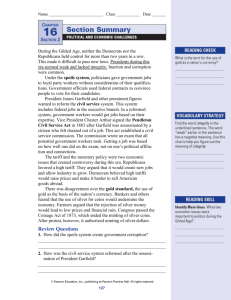Chapter 17 Railroads and the Gilded Age.doc
advertisement
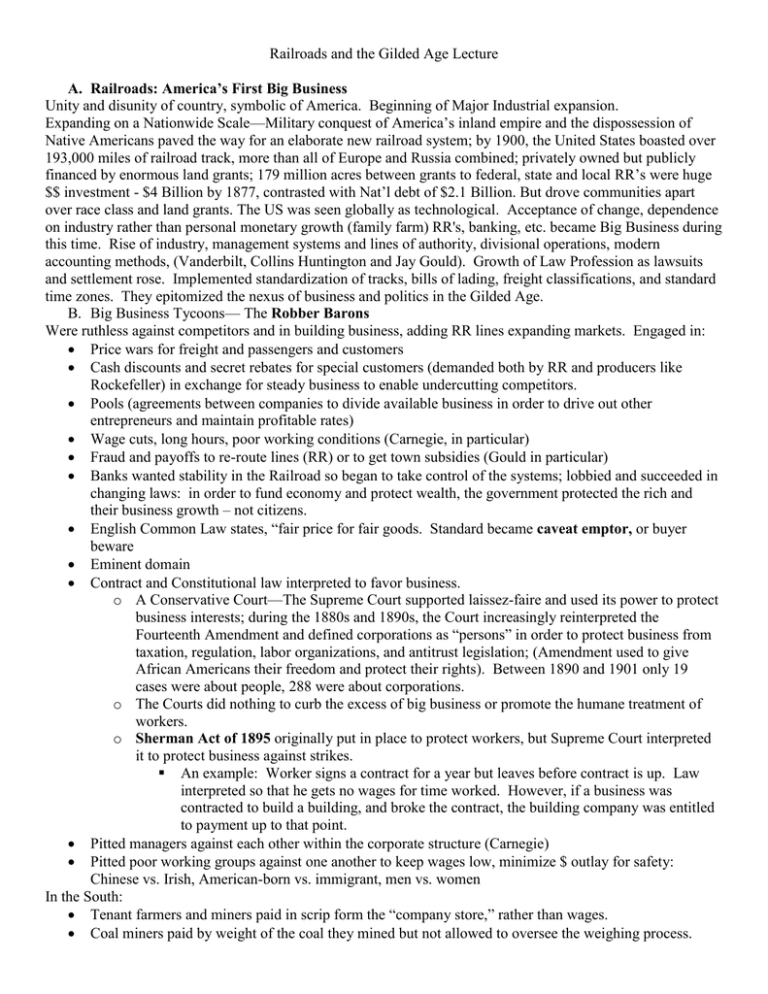
Railroads and the Gilded Age Lecture A. Railroads: America’s First Big Business Unity and disunity of country, symbolic of America. Beginning of Major Industrial expansion. Expanding on a Nationwide Scale—Military conquest of America’s inland empire and the dispossession of Native Americans paved the way for an elaborate new railroad system; by 1900, the United States boasted over 193,000 miles of railroad track, more than all of Europe and Russia combined; privately owned but publicly financed by enormous land grants; 179 million acres between grants to federal, state and local RR’s were huge $$ investment - $4 Billion by 1877, contrasted with Nat’l debt of $2.1 Billion. But drove communities apart over race class and land grants. The US was seen globally as technological. Acceptance of change, dependence on industry rather than personal monetary growth (family farm) RR's, banking, etc. became Big Business during this time. Rise of industry, management systems and lines of authority, divisional operations, modern accounting methods, (Vanderbilt, Collins Huntington and Jay Gould). Growth of Law Profession as lawsuits and settlement rose. Implemented standardization of tracks, bills of lading, freight classifications, and standard time zones. They epitomized the nexus of business and politics in the Gilded Age. B. Big Business Tycoons— The Robber Barons Were ruthless against competitors and in building business, adding RR lines expanding markets. Engaged in: Price wars for freight and passengers and customers Cash discounts and secret rebates for special customers (demanded both by RR and producers like Rockefeller) in exchange for steady business to enable undercutting competitors. Pools (agreements between companies to divide available business in order to drive out other entrepreneurs and maintain profitable rates) Wage cuts, long hours, poor working conditions (Carnegie, in particular) Fraud and payoffs to re-route lines (RR) or to get town subsidies (Gould in particular) Banks wanted stability in the Railroad so began to take control of the systems; lobbied and succeeded in changing laws: in order to fund economy and protect wealth, the government protected the rich and their business growth – not citizens. English Common Law states, “fair price for fair goods. Standard became caveat emptor, or buyer beware Eminent domain Contract and Constitutional law interpreted to favor business. o A Conservative Court—The Supreme Court supported laissez-faire and used its power to protect business interests; during the 1880s and 1890s, the Court increasingly reinterpreted the Fourteenth Amendment and defined corporations as “persons” in order to protect business from taxation, regulation, labor organizations, and antitrust legislation; (Amendment used to give African Americans their freedom and protect their rights). Between 1890 and 1901 only 19 cases were about people, 288 were about corporations. o The Courts did nothing to curb the excess of big business or promote the humane treatment of workers. o Sherman Act of 1895 originally put in place to protect workers, but Supreme Court interpreted it to protect business against strikes. An example: Worker signs a contract for a year but leaves before contract is up. Law interpreted so that he gets no wages for time worked. However, if a business was contracted to build a building, and broke the contract, the building company was entitled to payment up to that point. Pitted managers against each other within the corporate structure (Carnegie) Pitted poor working groups against one another to keep wages low, minimize $ outlay for safety: Chinese vs. Irish, American-born vs. immigrant, men vs. women In the South: Tenant farmers and miners paid in scrip form the “company store,” rather than wages. Coal miners paid by weight of the coal they mined but not allowed to oversee the weighing process. Use of prison laborers to depress wages “Iron-Clad” forced contracts. Jay Gould—The era’s most notorious speculator; knew little about railroads or their operation; operated the stock market like a shark; volume of stock on the New York Stock Exchange increased sixfold between 1869 and 1901; Gould became a master of corporate expansion through stock transactions and an architect of the vast railway systems that developed in the 1880s. The Pennsylvania Railroad by the 1870s boasted a payroll of more than 55,000 workers; capitalized at more than $400 million dollars, it was the largest private enterprise in the world; Gould and his competitor “Commodore” Cornelius Vanderbilt amassed fortunes estimated at $100 million; federal and state governments encouraged their growth by offering generous cash subsidies and land grants. Dangers of Railroad work. Worked for $1.75 per hour for 12-hour shift. In 1889 22,000 railroad workers were killed or injured, in 1888 over 5200 killed, 26,000 injured Andrew Carnegie and Carnegie Steel—Carnegie became one of America’s heroes; he turned away from speculation, striking out on his own to build the biggest steel industry in the world; self-made man who gave away more than $300 million before he died, most notably to public libraries; his story and his philanthropy burnished his public image; Carnegie built the most up-to-date Bessemer steel plant in the world on the outskirts of Pittsburgh; had easy access to two railroad lines and the Monongahela River, a natural highway up to Pittsburgh and the Ohio River and the coalfields farther north; cut the cost of making rails by more than half. By 1900, Carnegie Steel had expanded to include several plants and stood as the best-known manufacturer in the nation Vertical Integration—To guarantee the lowest costs and the maximum output, Carnegie pioneered a system of business organization called vertical integration; all aspects of business were under Carnegie’s control, from mining to transport to production. John D. Rockefeller, Standard Oil, and the Trust Oil Competition—The amount of capital needed to buy or build an oil refinery in the 1860s and 1870s remained relatively low; prompted rigorous competition among many small refineries. A New Corporate Structure—In 1882, Rockefeller pioneered a new form of corporate structure—the trust; differed from Carnegie’s vertical approach; used horizontal integration to control the refining process; allowed Standard Oil trustees to hold stock in various refinery companies “in trust” and to coordinate policy between the refineries; elaborate stock swap gave Rockefeller a monopoly of the oilrefining business and eventually paved the way for the establishment of trusts in other industries. In this way the company escaped state law restrictions for monopolies. Holding Companies—The public pressured the federal government to outlaw the trust as a violation of free trade; when the government threatened to outlaw the trust, Standard Oil changed its tactics and reorganized as a holding company; brought competing companies under one central administration; could act in concert because they were no longer technically separate businesses; by 1890, Standard Oil ruled more than 90 percent of the oil business; became the country’s first billionaire. Impact of Big Business on Society Who were the workers? – Immigrants (5-1/2 million in the 1880s and 4 million in the 1890s. Irish and Chinese. Working classes were fragmented by culture and neighborhoods. Irish resented Jewish coming into their neighborhoods, language differences. Continual violence against Chinese in West: Stoned and attacked in the streets b/c of ethnicity; forced child immigration and labor – children work for less $ and no child labor laws. Women usually in domestic positions, but some in mills and factories, also worked for less $. Single or widowed, usually. American middle and upper classes supported this skewed society. Comparing Business to Nature—Drawing on the work of the naturalist Charles Darwin, Herbert Spencer and William Graham Sumner developed a theory called social Darwinism; concluded that progress came about as a result of relentless competition in which the strong survive and the weak die out; Sumner coined the term “survival of the fittest.” Romanticized in books by Horatio Alger. Justifying Inequality—Social Darwinism equated wealth and power with “fitness” and argued that the unfit should be allowed to die off to advance the progress of humanity; held that any efforts by the rich to aid the poor would interfere with the laws of nature and slow evolution; in an age when the average worker earned $500 a year, social Darwinism justified economic inequality. “The Gospel of Wealth”—Andrew Carnegie softened some of the harshest features of social Darwinism in an essay titled “The Gospel of Wealth”; preached philanthropy and urged the rich to “live unostentatious lives” and “administer surplus wealth for the good of the people”; earned praise but gained few converts. Scientific Racism—justified neglect of the poor in the name of “race progress”; with so many of the poor coming from different races and ethnicities, social Darwinism fueled a new form of scientific racism; buttressed the status quo and reassured white Americans that all was as it should be. Laissez-Faire Government—Social Darwinism’s emphasis on the free play of competition and survival of the fittest encouraged the economic theory of laissez-faire; held that the government should not meddle in economic affairs, except to protect private property. Shaped American personality – the reliance on self, personal commitment, Hard Work ethic. Some Robber Barons came form poverty but most came from wealth made before or during the Civil War. Business Failures and Public Reaction, Finally— Railroad Consumers - Lack of planning soon led to overbuilding of the railways and increased competition between owners; because railroad owners lost money from this competition, they attempted to set up arrangements, or “pools,” setting rates and dividing territory among themselves; these informal agreements invariably failed because men like Jay Gould refused to play by the rules; the public’s opinion of Gould as “the most hated man in America” illustrated the barometer of attitudes toward big business in general. Labor Violence - Haymarket Riot of 1886 – Rose out of a labor dispute. Peaceful protest in Haymarket Square, Chicago. Bomb at McCormick plant, second at protest after detachment of almost 200 police showed up to disburse crowd. 66 police wounded, 8 killed – they fired into the crowd killing several and wounding 200. Absolutely no evidence in re to who threw bomb (theories abound: Agent Provocateur? Anarchists? Police themselves?) But 8 Anarchists were arrested, tried and executed. On trial for their ideas, not fact, and by guilt by association – evidence was flimsy. It was a game changer for Organized Labor. Trial got international attention and the Anarchists became a viable political party in US (were already in other nations) 1877 called the Year of Violence. Workers struck and were targets of violence perpetrated by owners, police or military. Police, military or hired “guards’ shot and beat protesters and strikers. Protesters threw rocks. In Baltimore general strike, Pres. Hayes sent in Federal troops when state militia, who sympathized with protesters, joined them. Baltimore strikes galvanized RR workers in PA, NJ and OH, Chicago and St. Louis. Rail Cars were set on fire, derailed and smashed. At the end of the strikes, over 100 dead, 1000 in jail. Labor Organization - Knights of Labor, American Federation of Labor (Samuel Gompers) Unions gained power and embraced strikes as a way to create change. Many followed – 150,000 members in 1886. Slogan was “ A Dollar a Day or Kansas!” With AF support, RR workers went on strike. Protection Laws – o Federal Regulation—Americans increasingly agreed on the need for federal regulation of the railroads and federal legislation against the trusts; the Patrons of Husbandry, or the Grange, spearheaded the midwestern states’ efforts to regulate the railroads. o The Interstate Commerce Commission—The Supreme Court proved hostile to state efforts to regulate the railroads; prompted Congress to pass the Interstate Commerce Act (1887), which created the nation’s first federal regulatory agency, the Interstate Commerce Commission (ICC). o The Sherman Antitrust Act—Concern over the growing power of the trusts led Congress to pass the Sherman Antitrust Act in 1890; outlawed pools and trusts; ruled that businesses could no longer enter into agreements to restrict competition; but the Supreme Court gutted this act, severely restricting its scope. o Government Intervention and Public Opinion—Both the ICC and the Sherman Antitrust Act testified to a growing concern about corporate abuses of power and to a growing willingness to use federal measures to intervene on behalf of the public interest; as corporate capitalism became more powerful, public pressure toward government intervention grew. Exposés—Journalist Ida B. Tarbell exposed Rockefeller’s unsavory business practices in a series of articles that appeared in McClure’s magazine from 1902 to 1905; contributed to the American people’s unfavorable opinion of Rockefeller as the symbol of heartless monopoly. Other literature shined light on unsafe practices – Jacob Riis and Henry George wrote scathing novels and commentaries in re to gap between wealthy and poor caused by monopoly of land by rich and the rents they charged. The Jungle by Sinclair Lewis an expose of the meatpacking industry practices that galvanized government to begin to regulate for safety of workers and of consumers. (Rats and other vermin, feces and other contaminants, unclean knives and other tools/clothes, etc.) D. New Inventions: The Telephone, the Telegraph and Electricity 1. Alexander Graham Bell—A Scottish immigrant; invented a way to transmit voice over wire—the telephone; soon Americans were communicating locally and across the country with long-distance telephone service. 4. The Communication Revolution—The telegraph, developed by Samuel F. B. Morse, marched alongside the railroad; formed the nervous system of the new industrial order; transformed business by providing instantaneous communication. 2. Thomas Alva Edison—Embodied the old-fashioned virtues of Yankee ingenuity and rugged individualism that Americans most admired; pioneered the use of electricity as an energy source; electricity became a part of American urban life by the late nineteenth century. 3. Corporate Dominance—The day of the inventor quietly yielded to the heyday of the corporation; electric industry consolidated in 1892, alienating Edison but dominating the market. II. From Competition to Consolidation A. J. P. Morgan and Finance Capitalism 1. The “Money Trust”—John Pierpont Morgan loathed competition and sought to eliminate it by substituting consolidation and central control; made him the architect of business mergers; dominated American banking and exerted an influence so powerful that his critics charged he controlled a vast “money trust.” 2. Reorganizing the Railroads—Morgan acted as a power broker in the reorganization of the railroads and the creation of industrial giants such as General Electric and U.S. Steel; efforts to consolidate the railroad industry exacted a heavy toll; his overcapitalization of railroads saddled them with enormous debt; the management style of the Morgan directors stressed short-term profit rather than long-term innovation and growth. 3. Challenging Carnegie—In 1898, Morgan turned to the steel industry, directly challenging Andrew Carnegie; supervised mergers of several smaller companies that expanded to compete with Carnegie; purchased Carnegie Steel for $480 million. 4. A New Corporate World—The acquisition signaled the passing of one age and the coming of another: Carnegie represented the old entrepreneurial order, Morgan the new corporate world; in 1901, Morgan pulled Carnegie’s competitors into a huge new corporation, United States Steel, the largest corporation in the world. A. Political Participation and Party Loyalty Patronage Politics—Politics in the Gilded Age was shaped by the spoils system; political parties in power doled out government jobs on the federal, state, and local levels to loyal supporters rather than the most qualified candidates. Party Loyalty—Political affiliation provided a powerful sense of group identity for voters who were proud of their loyalty to the Democrats or the Republicans. Religion and Ethnicity in Politics—Also played a significant role in politics; northern Protestants supported the Republican Party’s moral reforms; in the cities, the Democrats courted immigrants and working-class Catholic voters, saying the Republican moral crusades masked attacks on immigrant culture. B. Sectionalism and the New South 1. The Solid South? —Voters in the old Confederate South remained loyal Democrats in the years after Reconstruction; voted for Democratic candidates in every presidential election for the next seventy years; however, this was not true of politics at the state and local levels. 2. The New South—The South’s economy was devastated by the war and foundered, while the North experienced an unprecedented industrial boom; prompted a group of influential Southerners to call for a New South modeled on the industrial North; many Southerners, men and women, black and white, joined the national migration from farm to city, leaving the old plantations to molder and decay; the Redeemers invited northern industrial development; railroads opened up the region for industrial development. 3. Northern Control of Southern Industry—Southerners took pride in their iron and steel industry, which grew up in the area surrounding Birmingham, Alabama; but as long as control of southern industry remained in the hands of northern investors, it could not pose a legitimate threat to northern industry; northern owners inflated southern steel prices to benefit the North. 4. Industrial Illusions—In practical terms, the industrialized New South proved an illusion; much of the South remained agricultural, still dominating the tobacco industry, and caught in the grip of the crop lien system. III. Politics and Culture C. Gender, Race, and Politics 1. Limited Access to the Public Sphere—The concept of separate spheres dictated political participation for men only; blacks continued to face discrimination, especially in the New South, where Jim Crow segregation laws became more prominent. 2. Cross-Racial Alliances—In Virginia, the “Readjusters” formed as a coalition of blacks and whites determined to lower the state debt and spend more money on education; captured state offices from 1879 to 1883; crossracial alliances rested on the belief that universal political rights could be extended to black males in the public sphere without eliminating racial barriers in the private sphere; Democrats fought against cross-racial alliances, charging that black male political power threatened “white womanhood”; their argument prevailed. 3. Ida B. Wells and the Antilynching Movement—The notion that black men threatened white southern womanhood reached its most vicious form in the practices of lynching; in 1892, Ida B. Wells launched an antilynching movement; described lynching as a problem of race and gender and insisted that the myth of black attacks on white southern women masked the reality that mob violence had more to do with economics and the shifting social structure of the South than with rape; Wells’s strong stance met with reprisal, but she continued to hammer home her message in the United States and abroad; lynching did not end in Wells’s lifetime, nor did antilynching legislation gain passage in Congress; but her forceful voice brought the issue to national and international prominence. D. Women’s Activism 1. The National Woman Suffrage Association—Founded in 1869 by Elizabeth Cady Stanton and Susan B. Anthony; first independent woman’s rights organization in the United States. 2. Women’s Clubs—Despite their inability to vote or hold public office, women found ways to act politically; women’s clubs proliferated between the 1860s and 1890s; devoted themselves to civic usefulness; not about racial equality; the General Federation of Women’s Clubs barred black women’s clubs from joining so as not to alienate southern women. 3. Temperance—Temperance movement attracted by far the largest number of organized women in the late nineteenth century; women marched on taverns and saloons and refused to leave until the proprietors signed a pledge to quit selling liquor; brought the issue of temperance back into the national spotlight; led to the formation of the Woman’s Christian Temperance Union in 1874. 4. The Limits of Women’s Politics—Despite the political power women exerted, politics, particularly presidential politics, remained an exclusively male prerogative. IV. Presidential Politics A. Corruption and Party Strife 1. Reforming the Spoils System—The political corruption and party factionalism that characterized the Grant administration continued to trouble the nation in the 1880s; small but determined group of reformers believed that powerful business interests often contrived to control state legislatures and, through them, U.S. senators; championed a new ethic that would preclude politicians from getting rich from public office; wanted a constitutional amendment calling for the direct election of senators. 2. Republican Bosses—Republican Party remained divided into factions led by strong party bosses who boasted that they could make or break any candidate; Roscoe Conkling headed the “Stalwarts,” a faction that ridiculed civil service reform and tried to get the Republican Party to run Grant for president in 1880; James G. Blaine led the “Half-Breeds”; the “Mugwumps” consisted primarily of Republicans who sought civil service reform. 3. The Election of 1880—Hayes managed to alienate all factions in his party and decided not to seek reelection in 1880; the Republicans nominated a dark-horse candidate, James A. Garfield, and a Stalwart, Chester A. Arthur, to be his running mate; Garfield won. B. Garfield’s Assassination and Civil Service Reform 1. Garfield’s Brief Presidency—Garfield, like Hayes, faced the difficult task of remaining independent while pacifying the party bosses and placating the reformers; after less than four months in office, Garfield was assassinated by Charles Guiteau, a disgruntled office seeker who claimed to be motivated by political partisanship. 2. Calls for Reform—Assassination led the press to condemn Republican factionalism; attacks on the spoils system increased; the public soon joined the chorus demanding reform, which came with the passage of the Pendleton Civil Service Act in 1883; brought some fourteen thousand jobs under a merit system that required examinations for office and made it impossible to remove jobholders for political reasons. V. Economic Issues and Party Realignment A. The Tariff and the Politics of Protection 1. Debating the Tariff—In the 1880s, the tariff became a potent political issue; the high tariff generated a huge surplus that sat in the U.S. Treasury’s vaults, depriving the nation of money that might otherwise have been invested to create jobs and roads; many Americans—including southern and Midwestern farmers, advocates of free trade, and political moderates—agitated for tariff reform; other Americans, including industrialists and workers, opposed lowering the tariff. 2. A New Republican Coalition—Republican Party seized on the tariff issue to forge a new national coalition; an alliance of industrialists, labor, and western producers who benefited from the tariff in an effort to defeat the solidly Democratic South; the tactic worked, and Republican Benjamin Harrison was elected president in 1888. 3. Changing Views on the Tariff—Back in power, the Republicans passed the highest tariff in the nation’s history in 1890; but the strategy backfired; Americans had elected Harrison to preserve protection but not to enact a higher tariff; angry voters swept Republicans out of Congress in the election of 1890, and in 1892, Harrison lost to Grover Cleveland, whose call for tariff revision had lost him the election in 1888. 4. Deeper Social Divisions—The debate over the tariff masked deep divisions in American society between workers and farmers on one side and bankers and corporate giants on the other. V. Economic Issues and Party Realignment C. The Fight for Free Silver 1. Gold versus Silver—Tariff reform and regulation of the trusts gained many backers, but the issues surrounding silver stirred passions like no other issue of the day; on one side stood those who believed that gold constituted the only honest money; on the other side stood a coalition of western silver barons and poor farmers from the West and South who hoped that increasing the money supply with silver dollars, thus causing inflation, would give them some relief by enabling them to pay off their debts with cheaper dollars; called “free silver.” 2. The Greenback Labor Party—Alliance of farmers and urban wage laborers; favored issuing paper currency not tied to the gold supply; elected fourteen members to Congress in 1878. 3. Free Silver Advocates—After the Greenback Labor Party collapsed, proponents of free silver came to dominate the money debate in the 1890s; in 1890 with the Silver Purchase Act, Congress took steps to appease advocates of silver by passing legislation that required the government to buy silver and issue silver certificates; good for silver mining interests; did little to promote the inflation that farmers desired, and they continued to call for the free and unlimited coinage of silver. 4. Silver Politics—Democrats hoped to use the silver issue to achieve a union between western and southern voters; despite his party’s support for it, Democratic president Grover Cleveland’s repeal of the 1890 Silver Purchase Act in 1893 dangerously divided the country. D. Panic and Depression 1. The Panic of 1893—In 1893, President Cleveland had scarcely begun his second term in office when the nation fell into a deep economic depression; it appeared that the U.S. Treasury might not be able to meet its obligations and fall into bankruptcy. 2. Morgan’s Plan—J. P. Morgan suggested a plan whereby a group of bankers would purchase $65 million in U.S. government bonds, paying in gold; Cleveland accepted. 3. Continued Hardship—The press claimed incorrectly that both the president and Morgan reaped tremendous financial benefits from this transaction; Cleveland’s action managed to salvage the gold standard; did not save the country from hardship as the depression continued.

